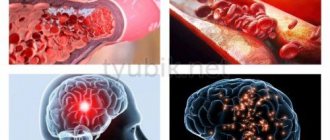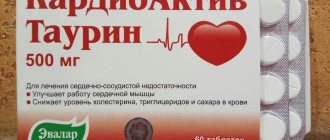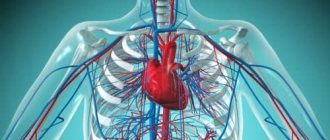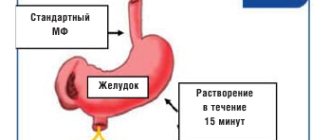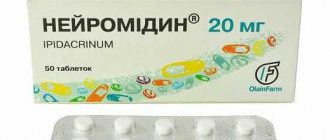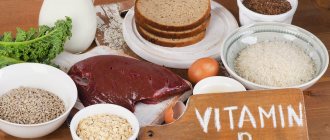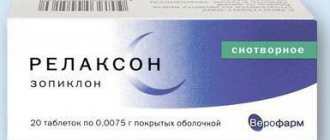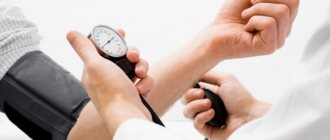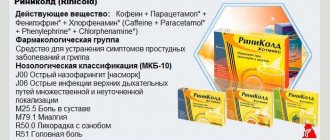It is important to follow the instructions for use of the drug Promedol to the letter, since this drug belongs to opioid analgesics (narcotic painkillers) and any violation of the established procedure for use can lead to serious health consequences.
The international nonproprietary name of the drug is Trimeperidine. In Latin the medicine is called "Promedolum"
pharmachologic effect
Just like Morphine and Fentanyl, it is an opioid receptor agonist.
Pharmacodynamics
- Has an analgesic effect (somewhat weaker and shorter than Morphine)
- Additional therapeutic effects: anti-shock, uterotonic, antispasmodic and mild hypnotic
- By activating the endogenous antinociceptive system, it disrupts the transmission of pain impulses between neurons at all levels of the central nervous system
- By influencing the higher parts of the brain, it changes the emotional color of pain sensations
- Depresses the respiratory center (less than Morphine)
- Stimulates the vagus nerve centers and the vomiting center
- Relieves spasms of smooth muscles of internal organs (here the drug is also inferior to Morphine)
- Helps dilate the cervix during labor
- Increases tone and provokes stronger contractions of the myometrium
- With any parenteral administration, the analgesic effect occurs within 10-20 minutes, reaches a peak after 40 minutes and lasts from 2-4 hours or more (with epidural anesthesia - more than 8 hours)
- When taken orally, the analgesic effect of Promedol is not so pronounced (1.5-2 times weaker than in the previous case)
Pharmacokinetics
- Very rapid absorption by any route of administration
- After administration of Promedol intravenously, the concentration of the active substance in the plasma decreases very quickly; after two hours only trace concentrations can be determined
- Plasma protein binding is 40%
- Metabolized in the liver by hydrolysis followed by conjugation
- Metabolites - meperidic and normeperidic acid
- Half-life – 2.5 – 4 hours (increases with renal failure)
- A small amount is excreted by the kidneys (5% unchanged)
Release form and composition
Dosage forms of Promedol:
- Injection solution (1 ml per ampoule, 5 ampoules in a plastic package, 1 package in a cardboard box; 1 ml per ampoule, 5 ampoules in a plastic package, 2 packages in a cardboard box with an ampoule knife or scarifier, as needed; for hospitals: 1 ml per ampoule, in contour plastic packaging 5 ampoules, in a cardboard box 20, 30, 40, 50 or 100 packages with an ampoule knife or scarifier, as necessary; 1 ml in a syringe tube, in a cardboard box 20 or 100 syringe tubes);
- Tablets (10 pcs. in a blister pack, 1 or 2 packs in a cardboard box).
The active ingredient is trimeperidine, the content depends on the form of release:
- Solution: 10 or 20 mg in 1 ml (in 1 ampoule – 10 or 20 mg; in 1 syringe tube – 20 mg);
- Tablets: 25 mg/piece.
Indications
Both tablets and Promedol solution are prescribed for moderate or severe pain. Thus, the indications for the use of the medicine are the following diseases and conditions:
- Injuries
- Burns
- Radiculitis lumbosacral
- Thalamic syndrome
- Acute neuritis
- Intervertebral disc protrusion
- Acute prostatitis
- Peptic ulcers of the stomach and duodenum
- Postoperative period
- With spasm of smooth muscles, which is accompanied by pain (renal, liver, intestinal colic). In this case, the use of Promedol is possible in combination with antispasmodic and atropine-like drugs)
- Chronic pancreatitis
- The drug Promedol is also prescribed for oncology
In addition to the above cases, there are also indications directly for Promedol solution in ampoules:
- Acute attack of glaucoma
- Acute vesiculitis
- Paranephritis
- Spontaneous pneumothorax
- Perforation of the esophagus
- Acute dysuria
- Paraphimosis
- Priapism
- Foreign bodies in the urinary canal, bladder or rectum
- Acute left ventricular failure
- Pulmonary edema
- Cardiogenic shock
- Neuroleptanalgesia (in combination with antipsychotics)
- Causalgia
- Acute pleurisy
- Air embolism
- Acute pericarditis
- Pulmonary infarction
- Hepatic artery thrombosis
- Thromboembolism of the arteries of the limb or pulmonary artery
- Dissecting aortic aneurysm
- Unstable angina
- Myocardial infarction
- Promedol is also used for pain relief during childbirth and to stimulate labor.
- Promedol is indicated before surgery, as well as during the operating and postoperative periods.
Contraindications
For all dosage forms
- Hypersensitivity of the body to the active substance or to any other component included in the drug
- Respiratory center depression
For tablets
- Cachexia
- Children under 2 years of age (tablets should not be taken by children due to the inability to accurately calculate the dosage)
For Promedol injections
- Current infectious diseases (high risk of infection spreading through the central nervous system)
- Slowing the elimination of toxins from the body, and, as a consequence of this condition, acute and prolonged diarrhea
- Diarrhea that occurred against the background of pseudomembranous colitis, which was caused by taking drugs from the penicillin, cephalosporin, and lincosamide groups
- Poor blood clotting (including if the disease occurs after anticoagulant therapy for spinal or epidural anesthesia)
- Taking monoamine oxidase inhibitors and the 21-day period after discontinuation of these drugs
- Children under 2 years old
Relative contraindications (with caution)
- Hypothyroidism
- Myxedema
- Kidney or liver failure
- Central nervous system depression
- Traumatic brain injury with psychosis
- Respiratory failure
- Urethral stricture
- Prostate dysplasia
- Adrenal insufficiency
- Elderly age
- Alcoholism
- Suicidal tendencies
- Convulsions
- Marked emotional lability
- Traumatic brain injury
- Drug addiction (including history)
- Severe inflammatory bowel disease
- Arrhythmia
- Arterial hypotension
- Bronchial asthma and chronic obstructive pulmonary diseases
- Surgical interventions on the urinary system and gastrointestinal tract
- Chronic heart failure
- Weakened state of a sick person
- Promedol should also be prescribed with caution during pregnancy and lactation.
Consequences of use and development of addiction
Dependence develops due to long-term use of the drug (for example, in case of a serious injury), addiction to other drugs of the opium group - promedol, whose price is lower and more accessible, replaces them. Using the drug, patients become indifferent to everything that happens around them and are in a state of relaxation, to which they quickly get used. The drug has a weaker effect than other opiate drugs, but its abuse leads to:
- psycho-emotional disorders, apathy, depression, the appearance of suicidal thoughts;
- diseases of the liver, genitourinary and cardiovascular systems;
- blood clotting disorders;
- gastrointestinal disorders - nausea, vomiting, and so on.
Dependence develops due to internal cravings and social reasons - a prescription for promedol in pharmacies is often not required, it is inexpensive and easily accessible. Due to its water solubility, it is easy to consume. Promedol, which is offered for purchase on many semi-criminal websites, becomes the reason for the transition to “hard” drugs - heroin and morphine.
Drug addicts lose interest in life and become emotionally unstable. Apathy gives way to aggression, depression develops into severe forms. If the drug is administered by injection, there is a high risk of infection and inflammation. Due to withdrawal symptoms, patients are unable to cope with the situation on their own.
Side effects
Nervous system:
- Drowsiness
- Weakness
- Vertigo
- Headache
- Diplopia
- Blurred vision
- Nightmares
- Unusual dreams
- Restless sleep
- Nervousness
- Fatigue
- General discomfort
- Tremor
- Convulsions
- Involuntary muscle twitching
- Depression
- Hallucinations
- confusion euphoria
- Disorientation
- Slowing of psychomotor reactions
- Stiffness of the respiratory muscles
- Tinnitus
Digestive system:
- Gastrointestinal irritation
- Nausea
- Vomit
- Constipation
- Spasms of the biliary tract
- Dry mouth
- Anorexia
- Toxic megacolon
- Paralytic ileus
- Hepatoxicity
The cardiovascular system:
- Decreased blood pressure (less commonly, increased blood pressure)
- Arrhythmia
Urinary system:
- Spasm of the ureters (pain when urinating, frequent urge)
- Decreased total urine output
Respiratory system:
- Respiratory center depression
- Apnea
Allergic and local reactions:
- Angioedema
- Bronchospasm
- Laryngospasm
- Facial swelling
- Itching
- Skin rash
- Redness, burning and swelling at the injection site
Other:
- Drug dependence (addiction)
- Increased sweating
Important! During treatment, it is necessary to refrain from drinking alcohol, performing hazardous types of work, and driving a vehicle.
Drug interactions
Possible interaction reactions when combining Promedol with other drugs:
- Muscle relaxants, ethanol, general anesthesia, anxiolytics, antipsychotics (neuroleptics), hypnotics and sedatives, other narcotic analgesics - aggravated respiratory and central nervous system depression;
- Barbiturates (especially phenobarbital) – the analgesic effect decreases;
- Drugs that lower blood pressure (including ganglion blockers, diuretics) – their hypotensive effect increases;
- Antidiarrheals (including loperamide) and drugs with anticholinergic activity - the threat of urinary retention and constipation (up to the development of intestinal obstruction) is aggravated;
- Anticoagulants – their effectiveness increases (it is necessary to control plasma prothrombin);
- Buprenorphine (including previous treatment) - the effect of trimeperidine is reduced;
- Naloxone – helps restore breathing, reduce depression of the central nervous system, eliminate analgesia, accelerate the development of “withdrawal syndrome” in drug addiction;
- Monoamine oxidase inhibitors - severe reactions may occur due to overexcitation or inhibition of the central nervous system with the development of hypotensive or hypertensive crises;
- Naltrexone – against the background of drug addiction, there is an acceleration in the appearance of symptoms of “withdrawal syndrome” (difficult to eliminate and persistent symptoms can appear within 5 minutes after using the drug and last for 48 hours); the effectiveness of trimeperidine decreases; symptoms associated with the histamine reaction do not change;
- Metoclopramide – its effect decreases.
Instructions for use
Pills
- The maximum daily dose of Promedol in tablets is 200 mg (8 tablets)
- Maximum single dose – 50 mg (2 tablets)
- Depending on the diagnosis, take 1-2 tablets 3-4 times a day
- If the pain for which the use of the drug is indicated is due to spasm of smooth muscles, the drug is combined with antispasmodics and atropine-like drugs
Solution
Instructions for using Promedol in ampoules look like this:
- The solution in ampoules is administered intramuscularly and intravenously, in syringe tubes - intramuscularly and subcutaneously
- Depending on the diagnosis, adults are prescribed 10-40 mg of medication (0.5-2 ml of solution)
- For premedication, the solution is administered intramuscularly or subcutaneously 35-40 minutes before surgery. 20-30 mg of active ingredient is combined with about.5 mg of Atropine
- If anesthesia is carried out using Promedol, the drug is administered in fractional doses of 3-10 mg
- The permissible single dose of the solution is 40 mg, the daily dose is 160 mg.
For children
Promedol is prescribed to children from two years of age, 3-10 mg, depending on the age of the child.
During childbirth
Promedol during childbirth is used to relieve pain and to stimulate labor. In this case, the drug is administered intramuscularly or subcutaneously, with a volume of 20-40 mg. A number of mandatory conditions for using the drug in this case: normal condition of the fetus, dilation of the uterus by 3-4 centimeters, administration of the last dose no later than 60 minutes before delivery.
How to get rid of addiction to promedol
Traditional drug addiction programs emphasize drug rehabilitation. In the case of a drug, the approach is ineffective. Dependence on promedol is largely psycho-emotional, so an integrated approach is required. It is implemented by the Narconon program. The course, which usually lasts 8-10 weeks, includes non-drug weaning from the drug and practices that help the patient return to a healthy life forever.
The program has several stages:
- non-drug weaning - pain and discomfort are relieved using assisted techniques;
- eliminating the consequences of toxic damage to the body using “New Life” techniques - sauna, running, special nutrition, taking niacin and mineral complexes;
- restoration of healthy communication skills using “Objective Processes” methods;
- liberation from the past with support in leaving the previous circle of friends - “Personal values” and “Overcoming ups and downs in life”;
- developing constructive problem solving skills and obtaining tools to stop drug use in the future - “Changing conditions in life” and “Life skills”
The program eliminates relapses, breakdowns and returns to the past. Its effect lasts for life.
Share:
Phenazepam
Phenobarbital
Overdose
Symptoms:
- Dizziness
- Lower blood pressure
- Confusion
- Headache
- Cold sticky sweat
- Nervousness
- Fatigue
- Nausea
- Vomit
- Drowsiness
- Sharp weakness
- Decreased body temperature
- Labored breathing
- Miosis
- Convulsions
- Hypoventilation
- Cardiovascular failure
- In severe cases - respiratory arrest, loss of consciousness, coma
Treatment:
- Artificial ventilation
- Symptomatic therapy
- Use of the opioid antagonist - Nolaxon (0.4 -2 mg intravenously for adults, 0.01 mg per kg - for children)
Reviews
To finally form an opinion about Promedol, let's get acquainted with the reviews of patients who have already undergone such treatment. Anna, 25 years old I was injected with Promedol to ease a difficult birth (the contractions were strong, but the dilatation was small). After the injection I fell asleep, I felt contractions, but not much. I slept for 4 hours, after which the pain returned, and two hours later I gave birth. In principle, I did not feel any side effects. Irina, 71 years old This drug was injected intravenously into my husband after surgery to remove kidney stones. The pain was very strong, so it became easier, you could agree to anything, you don’t think about side effects at such moments. But for us everything worked out, except for nausea and dizziness. But the pain went away, and the person was able to rest peacefully after the operation. Oleg, 35 years old. I also received an injection with this medicine after the operation. And the nightmare began: vomiting, nausea, dizziness, and high blood pressure. I had terrible dreams, or could not sleep at all. Apparently this is not my drug at all.
